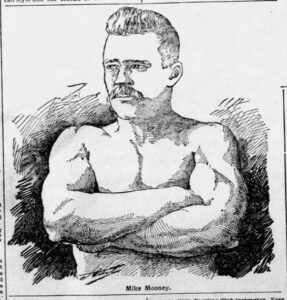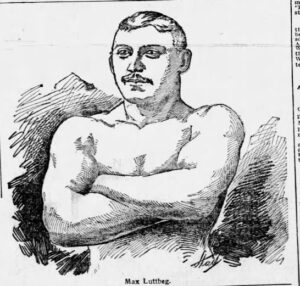穆尼摔跤 Luttbeg
上週六, 12月2日, 1893, 當地的聖路易斯拳擊教練和希臘羅馬摔跤手 Mike Mooney 在聖路易斯會見了 Max Luttbeg’ 娛樂廳. 賽前炒作集中在穆尼從不輸掉摔跤比賽或拳擊比賽.
穆尼被認為是更好的希臘羅馬摔跤手, 而 Luttbeg 是一個更好的抓捕摔跤手. 在 19 世紀, it was common for matches to be contested in different styles during different falls. 在 2 出 3 摔倒比賽, you could have one fall contested in Greco-Roman, one fall contested catch-as-catch-can and the other fall could be one of those styles or a different style altogether.

19Th Century St. 路易斯拳擊教練和專業摔跤手邁克·穆尼(Mike Mooney) (公共領域)
對於這場比賽, Luttbeg had won the pre-match coin toss. The bout would be two falls contested in catch-as-catch-can style and one fall contested in Greco-Roman wrestling, if all three falls were necessary. This format would favor Luttbeg, who was representing the Pastime Athletic Club. Mike Mooney would be representing the Missouri Gymnasium. The match would be for $100 aside plus a portion of the gate receipts. Due to the format of the match, Luttbeg was a 5 至 4 favorite in betting odds.
The match did progress as folks thought it would but it wasn’t without controversy due to a referee’s decision. A referee named Oysterholtz from the South Side Saint Louis Turnverein Hall was selected to referee the Luttbeg-Moody bout.
Mooney initially insisted that the first fall be Greco-Roman wrestling, since he would be at a disadvantage if the bout went all three falls. 然而, Luttbeg refused to concede the point. Mooney eventually accepted a format of the first fall contested catch-as-catch-can, the second fall contested Greco-Roman wrestling and the third fall, if needed, contested catch-as-catch-can.
The men started off the match by wrestling for 5 minutes before Luttbeg was able to take a half-Nelson and body hold. Luttbeg used his superior position to turn Moody onto his back after a few seconds. The referee awarded the fall to Luttbeg but there was a loud protest from the crowd.
The spectators on the side of the mat, where the shoulders of Mooney were facing, did not believe Mooney’s shoulders touched the ground. 然而, Oysterholtz refused to concede. He said he knew as much about wrestling as any man in the place and that Luttbeg had scored the fall on Mooney. 然而, Oysterholtz did resign his position as referee after the first fall.

Artist rendering of Max Luttbeg, catch-as-catch-can wrestling instructor and part-time pro wrestler in 1893 (公共領域)
After securing a local newspaper man to referee the rest of the bout, the second fall continued but this time in the Greco-Roman style. Mooney was much superior in this style and after wrestling about 8 minutes secured a body hold and threw Luttbeg for the second fall. The match was tied at one fall apiece.
Unfortunately for Mooney, the third fall was catch-as-catch-can. Luttbeg was just too much for Mooney in this style. 後 7 分鐘, Luttbeg was able to grabbed a catch hold and threw Mooney onto his back for the third fall and the bout. It was Mooney’s first recorded loss in a wrestling match.
Wrestling trends would favor Luttbeg’s style. Catch-as-catch-can would virtually replace all other styles in American professional wrestling by 1900. Outside of a failed experiment to bring back Greco-Roman wrestling in 1915, it was more of a novelty style in the professional ring.
Mike Mooney was okay because his primary job was teaching boxing to men at the Missouri Gymnasium. With the physical culture craze of the late 19th century, which would mirror the physical fitness craze in the 1970s and 1980s, physical trainers could make a living training people in the late 19th Century.
William Muldoon would retire as world heavyweight wrestling champion in 1889 to open his own training farm called Olympia up in New York State. Training business men took a much lighter toll on the body than professional boxing or wrestling.
You can leave a comment or ask a question about this or any post on my Facebook頁面.
Sources: Saint Louis Post-Dispatch, November 30th, 1893 版, P. 6, 12月2日, 1893 版, P. 8 and December 3rd, 1893 edition p. 1.

